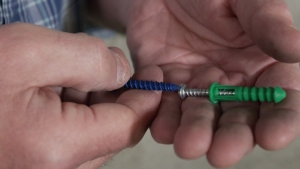How to Extract Small Finish Nails Without Damaging the Surrounding Surface
Make a Tool to Reach and Grip Stubborn Finish Nails
Removing an unwanted finishing nail, without doing damage to the wood surrounding it, can be a bit of a challenge. There is a way to accomplish it, which involves making a tool just for that purpose.
Start with a pair of old diagonal cutters. The idea is to remove the bevel on the back side of the tool.
Use a belt sander to grind away some of the material from the back of the cutters.
It's also helpful to grind the sides to form a point at the end of the cutters.
After sanding, the back of the cutters should be virtually flat.
Place the sharp, pointed ends on either side of the nail. Push them slightly into the wood, then squeeze the handles and grip the nail right below the head.
Repeatedly rock the cutter back and re-grip the nail to pull it out of the wood.
Use a piece of scrap wood to increase the range of motion if necessary.
With the nail removed, all that remains is a clean hole that's a snap to fill.
Blog Articles
Have You Heard of Landscape Glue?
You love the rustic charm of a gravel walkway, but the constant scattering of stones across your lawn and patio can be a real headache. Whether it’s from pets, lawn mowers, or just foot traffic, it seems impossible to keep those stones in place. Sound familiar? Well, Brian shows us a simple DIY method using landscape glue to keep your gravel path looking pristine and, more importantly, in place.
How to Remove Candle Wax Drips: Two Effective Methods
Candles create a warm and inviting atmosphere, but those pesky wax drips can be a real headache. Luckily, Brian shows us a couple of effective methods to tackle this issue, and they involve two very different temperatures: hot and cold. Here, we'll explore two effective methods: one using cold and the other using heat.
Guide to Hanging on Masonry Walls
Ever wondered how to hang that picture frame or shelf on a brick or concrete wall? It can seem daunting, but with the right tools and techniques, it's a straightforward DIY project. This guide breaks down two common methods: using concrete screws and using anchors, making it easy for you to tackle your next hanging project.





